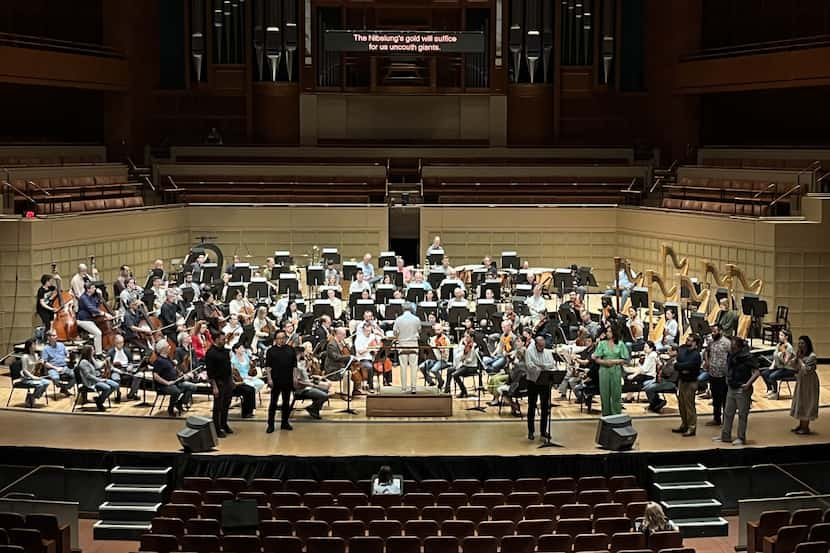It’s one of the great epics of Western civilization, a four-part drama of family dysfunction and betrayal, of gods and mortals, giants and dwarfs, sacrifice and ultimate cleansing and renewal by fire and water. First performed as a cycle in 1876, Richard Wagner’s The Ring of the Nibelung represented bold new theatrical conceptions, and it has inspired subsequent stagings of mind-boggling imagination (and sometimes perversity).
The operatic tetralogy was also musically innovative, exploring new harmonic ambiguities and new orchestral colors. Continuous flows of music replaced the separate recitatives and arias of earlier operas. Recurrent musical themes called leitmotifs represented individual characters, settings, concepts, even a magic sword — and sometimes hidden thoughts.
Wagner called his Ring a Gesamtkunstwerk, a complete artwork melding language, scenery, dramatic interactions and newly expressive music. The Dallas Symphony Orchestra, though, is presenting the first two Ring operas — Das Rheingold and Die Walküre — in semi-staged performances at the Meyerson Symphony Center. The remaining two operas, Siegfried and Götterdämmerung, will be presented in October, along with the entire four-opera cycle in sequence.
With no sets and minimal props, singers will enact the drama on an additional forward stage extension — and sometimes on the choral terrace. Coordinating with singers via video monitors, music director Fabio Luisi will conduct the orchestra upstage. Simultaneous English translations will be projected over the stage.
Luisi’s extensive and acclaimed experience in major opera houses on both sides of the Atlantic included seven years as principal conductor at the Metropolitan Opera in New York. He conducted the Met’s Ring, DVDs of the last two operas garnering a Grammy Award. At his 2018 DSO appointment, Luisi announced plans for regular concert performances of operas. (Former music director Jaap van Zweden conducted a concert performance of Die Walküre in 2018.)
The DSO’s semi-staging is by Italian director Alberto Triola, who also directed DSO performances of Strauss’ Salome (2020) and Tchaikovsky’s Eugene Onegin (2022).
Casts include Mark Delavan (Wotan), Stefan Margita (Loge), Deniz Uzun (Fricka), Tómas Tómasson (Alberich), Liang Li (Fasolt), Andrew Harris (Fafner), Sara Jakubiak (Sieglinde), Christopher Ventris (Siegmund), Stephen Milling (Hunding) and Lise Lindstrom (Brünnhilde).
Staging with light
The Ring revolves around a collection of gold with magical powers. Over the course of many episodes, characters both human and divine cheat, steal and murder to access that power. Ultimately, the gods themselves are doomed by the double-dealing of their head, Wotan, leading to collapse of the old world order and a new beginning.
With Wagner’s interweaving of philosophy, German and Norse myths — and socio-political critiques — both new and revived Ring stagings draw passionate devotees from around the world. How will each production portray fantastic scenes in the Rhine River, in a subterranean sweatshop, on a fire-ringed mountain and in a heavenly palace? Even for major international opera houses, assembling casts of necessarily heroic voices is a challenge, although a concert performance or semi-staging commits singers for less time.
With limited space, technical resources and rehearsal time, Triola had to devise a less obvious visual presentation.
“I found inspiration in light,” he says. “The music of Wagner is full of light. I have associated one color to each character, and each environment, and in some cases objects have their own colors. Das Rheingold is the most colorful of the four operas, finishing with a rainbow.”
Triola also will use some spaces apart from the stage extension. The Meyerson’s big C.B. Fisk organ will represent Valhalla, the new heavenly palace the gods prepare to enter at the end of Das Rheingold.
In our day of Regietheater — director’s theater — when Ring productions are as likely to perplex as illuminate, Luisi wanted more emphasis on the music.
“I hope the audience will be involved with this music,” he says, “that they can let go with the music, just be carried along by the music, without visual distraction. I try to make the visual experience less important in order to increase the importance of the auditory experience. For us musicians, it is ideal to do it in this concert form.
“The music is not always illustrating what’s happening onstage, but sometimes what the characters are not saying. When they are lying, you hear it in the music, and they lie all the time. It is a socio-political piece.”
Instrumental novelties
It’s a cliché that Wagner’s music is loud, and it certainly has some powerful climaxes. But most of the Ring is of moderate or even quiet sound levels. It does, however, call for some unusual instruments and combinations.
The score specifies, among other things, 12 harps (usually reduced to six), eight horns (four doubling on Wagner tubas), bass trumpet, contrabass trombone and, for the subterranean smithy, 18 anvils. What are called Wagner tubas, or tuben, were conceived by Wagner himself to bridge the sonic gap between horns and trombones. They look like small tubas with angled bells at the tops.
“They create an entirely unique, surreal and otherworldly sound concept and emotional effect whenever the theme for Valhalla is played,” says DSO principal horn Daniel Hawkins. “The tuben and horns use the same mouthpiece, and it is not uncommon for horn players to learn how to switch back and forth between these two instruments nowadays.”
Two of the Wagner tubas here will be played by DSO musicians, two by guests. This will be the first outing for a brand new set of handmade Wagner tubas from the Viennese maker Andreas Jungwirth. “These new instruments are beautiful works of art,” Hawkins says, “and they sound so majestic.”
Yet another challenge is scheduling unionized symphony orchestra musicians, accustomed to two-hour concerts, for operas that, in the case of the last Ring opera, Götterdämmerung, can last five hours (with intermissions).
“We had several discussions with the orchestra committee, making sure we were staying within the contract as much as possible,” says Katie McGuinness, the DSO’s chief artistic officer. “And when we had to stretch the rules of the contract, we had lengthy discussions with the musicians.
“I think they’re really excited about this opportunity, so they want to embrace this.”
We’ll have to wait till October for the completion of the DSO Ring, and for that great Redemption theme that soars at the end of Götterdämmerung. But along the way, Wagner’s great epic plumbs depths and scales summits of human experience, in music of unparalleled glory.
“As a conductor, my life changed when I first did the Ring,” Luisi says. “My life as a musician and as a human being. You get a new understanding of pace and time.
“At the end of my first Götterdämmerung, I was enlightened. I was not tired at all. I was euphoric and enlightened. It was an unbelievable experience.”
Details
The Dallas Symphony Orchestra and singers perform Das Rheingold at 7:30 p.m. May 1 and 4, and Die Walküre at 6 p.m. May 2 and 3 p.m. May 5. All performances at Meyerson Symphony Center, 2301 Flora St., Dallas. Each performance $60 to $303. 214-849-4376, dallassymphony.org.


/cloudfront-us-east-1.images.arcpublishing.com/dmn/IKEVT7U2N5CEJDF6DP2PGVVBJM.jpg)
/cloudfront-us-east-1.images.arcpublishing.com/dmn/ZFJWX63LQRF42Q2PTATHP6RPQY.jpg)
/cloudfront-us-east-1.images.arcpublishing.com/dmn/7PJ7Y4VIDYIS32CXXLS7CT77Z4.jpg)
/cloudfront-us-east-1.images.arcpublishing.com/dmn/CFAA2WNNANBFDLACCGGYNX5ORY.jpg)
/cloudfront-us-east-1.images.arcpublishing.com/dmn/BNVJWBKVZ5GMTJ6WQRIUYBD2H4.jpg)